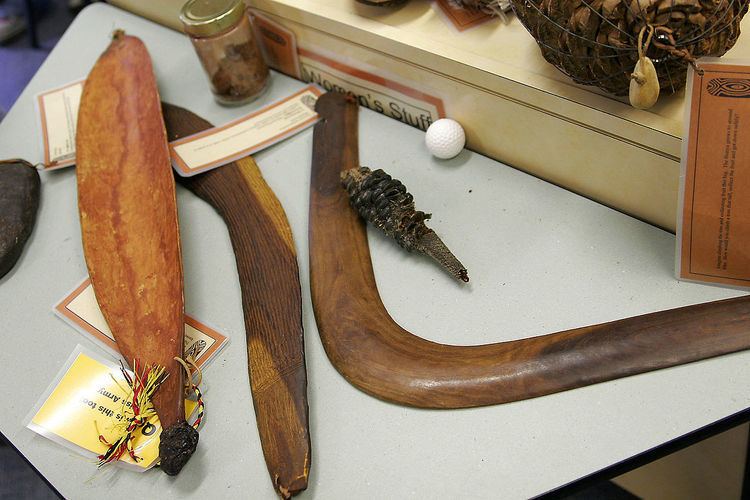 | ||
The throwing stick or throwing club is one of the first weapons used by early humans and cultures all around the world. In essence, it is a stave or wooden club thrown as a projectile to hunt small game such as rabbits or waterfowl. In flight, it rotates rapidly, hitting the target with one of the ends, maiming or killing it. One difference between a throwing stick and a javelin is in their shapes and lengths. A javelin is almost always a straight shaft with either a pointed tip or a spearhead attached to the front end. A throwing stick can be straight like a pointed wooden shaft or curved like the boomerang, and is much shorter than the javelin. It became obsolete as slings and bows became more prevalent, except for on the Australian continent, where it was developed to a high technology. Throwing sticks shaped like returning boomerangs are designed to fly straight to a target at long ranges. Their surfaces are shaped as airfoils. When tuned correctly they do not exhibit curved flight, but rather they fly on an extended straight flight path. Straight flight ranges greater than 100 meters distance have been reported by historical sources as well as in recent research. There were some throwing sticks placed in the tombs of pharaohs.
Contents
Distribution
The throwing stick is a tool used in hunting small game and waterfowl. The Ancient Egyptians used throwing sticks to hunt ducks, as seen in several wall paintings. The 18th dynasty Pharaoh Tutankhamun was a known lover of duck hunting and used the throwing stick in his hunts. Menceys, the kings of the ancient Guanches of the Canary Islands, also used throwing batons. Gimel, the third letter of many Semitic alphabets, may have been named after a weapon that was either a staff sling or a throwing stick, ultimately deriving from a Proto-Sinaitic glyph based on an Egyptian hieroglyph. The Aborigines of Australia used the boomerang. Although returning boomerangs are found in many Aboriginal cultures and will return to the user if thrown properly, the choice weapon of the Aborigines and most cultures was the heavy throwing stick, known internationally as the kylie. it's range was in excess of 100 meters and it could also be wielded as a club or knife for attacking close kangaroo, wallaby, and emu by using it as a club.
Some Native American tribes such as the Hopi, as well as all southern California tribes, utilized the throwing stick to hunt rabbits and occasionally deer.
Other titles for the throwing stick are: rabbit stick, throwing club, killer stick, baton, boomerang, and kylie. The throwing stick can also be used as a weapon in human combat, though the heavy non-return boomerang was the only one truly effective in this use.
Survival tool
As a survival tool, the throwing stick is one of the most effective and easiest tools to obtain. Other than a weapon, it can also be used as a digging tool for making fire-pits and underground shelter. A curved limb will suffice as a throwing stick. Ancient throwing sticks were made of hardwood with a weighted or curved end to one side to impart momentum so the stick stays straight and does not wobble in mid-flight.
Variations
Some throwing sticks and their variations are about 2 to 3 feet long pieces of thick hardwood, usually about the circumference of the user's wrist. When they are thrown, they spin, creating the image of a sort of blurry disc.
Pommel Point Throwing Sticks are not actual variations of the throwing stick. They are simply throwing sticks with slightly blunt points that can crush skulls if they travel at sufficient speed. Thus, it is also dubbed the skull crusher throwing stick.
Return boomerangs have a flat convex surface that must be thrown upright with a sharp flick of the wrist, but throwing sticks are thrown horizontally.
